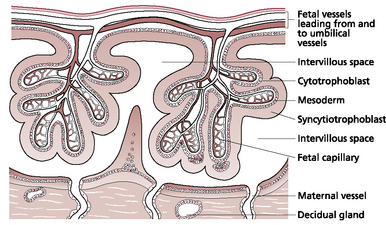Chapter 4 The Placenta
Development
• This part of the trophoblast is known as the chorion frondosum and it will eventually develop into the placenta.
• The villi under the capsular decidua, being less well nourished, gradually degenerate and form the chorion laeve, which is the origin of the chorionic membrane.
The villi erode the walls of maternal blood vessels as they penetrate the decidua, opening them up to form a lake of maternal blood in which they float. The maternal blood circulates slowly, enabling the villi to absorb food and oxygen and excrete waste. Each chorionic villus is a branching structure arising from one stem (Fig. 4.1). The placenta is completely formed and functioning from 10 weeks after fertilisation.
Circulation through the placenta
• Fetal blood, low in oxygen, is pumped by the fetal heart towards the placenta along the umbilical arteries and transported along their branches to the capillaries of the chorionic villi.
• Having yielded up carbon dioxide and absorbed oxygen, the blood is returned to the fetus via the umbilical vein.
• The maternal blood is delivered to the placental bed in the decidua by spiral arteries and flows into the blood spaces surrounding the villi. It is thought that the direction of flow is similar to a fountain; the blood passes upwards and bathes the villus as it circulates around it and drains back into a branch of the uterine vein.
It is impossible for the maternal and fetal circulations to mix unless any villi are damaged.
The mature placenta
Functions
The ‘Green B’ mnemonic (Box 4.1) can be helpful.
Box 4.1 Functions of the mature placenta
• Glycogen storage plus iron and fat-soluble vitamins
 Human chorionic gonadotrophin (HCG) – is produced by the cytotrophoblastic layer of the chorionic villi
Human chorionic gonadotrophin (HCG) – is produced by the cytotrophoblastic layer of the chorionic villi Oestrogens – as the activity of the corpus luteum declines, the placenta takes over the production of oestrogens
Oestrogens – as the activity of the corpus luteum declines, the placenta takes over the production of oestrogensStay updated, free articles. Join our Telegram channel

Full access? Get Clinical Tree



